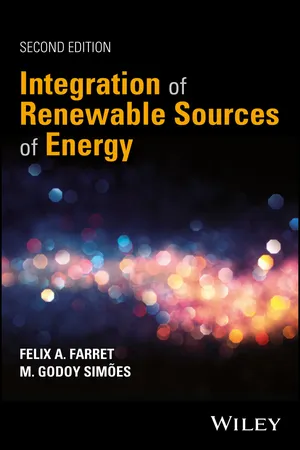
- English
- ePUB (mobile friendly)
- Available on iOS & Android
Integration of Renewable Sources of Energy
About this book
The latest tools and techniques for addressing the challenges of 21st century power generation, renewable sources and distribution systems
Renewable energy technologies and systems are advancing by leaps and bounds, and it's only a matter of time before renewables replace fossil fuel and nuclear energy sources. Written for practicing engineers, researchers and students alike, this book discusses state-of-the art mathematical and engineering tools for the modeling, simulation and control of renewable and mixed energy systems and related power electronics. Computational methods for multi-domain modeling of integrated energy systems and the solution of power electronics engineering problems are described in detail.
Chapters follow a consistent format, featuring a brief introduction to the theoretical background, a description of problems to be solved, as well as objectives to be achieved. Multiple block diagrams, electrical circuits, and mathematical analysis and/or computer code are provided throughout. And each chapter concludes with discussions of lessons learned, recommendations for further studies, and suggestions for experimental work.
Key topics covered in detail include:
- Integration of the most usual sources of electrical power and related thermal systems
- Equations for energy systems and power electronics focusing on state-space and power circuit oriented simulations
- MATLAB® and Simulink® models and functions and their interactions with real-world implementations using microprocessors and microcontrollers
- Numerical integration techniques, transfer-function modeling, harmonic analysis, and power quality performance assessment
- MATLAB®/Simulink®, Power Systems Toolbox, and PSIM for the simulation of power electronic circuits, including for renewable energy sources such as wind and solar sources
Written by distinguished experts in the field, Integration of Renewable Sources of Energy, 2nd Edition is a valuable working resource for practicing engineers interested in power electronics, power systems, power quality, and alternative or renewable energy. It is also a valuable text/reference for undergraduate and graduate electrical engineering students.
Frequently asked questions
- Essential is ideal for learners and professionals who enjoy exploring a wide range of subjects. Access the Essential Library with 800,000+ trusted titles and best-sellers across business, personal growth, and the humanities. Includes unlimited reading time and Standard Read Aloud voice.
- Complete: Perfect for advanced learners and researchers needing full, unrestricted access. Unlock 1.4M+ books across hundreds of subjects, including academic and specialized titles. The Complete Plan also includes advanced features like Premium Read Aloud and Research Assistant.
Please note we cannot support devices running on iOS 13 and Android 7 or earlier. Learn more about using the app.
Information
1
Alternative Sources of Energy
1.1 Introduction
1.2 Renewable Sources of Energy
Table of contents
- Cover
- Title Page
- Table of Contents
- Foreword for the First Edition
- Foreword for the Second Edition
- Preface for the First Edition
- Preface for the Second Edition
- Acknowledgements
- 1 Alternative Sources of Energy
- 2 Principles of Thermodynamics
- 3 Hydroelectric Power Plants
- 4 Wind Power Plants
- 5 Thermosolar Power Plants
- 6 Photovoltaic Power Plants
- 7 Power Plants with Fuel Cells
- 8 Biomass‐Powered Microplants
- 9 Microturbines
- 10 Earth Core and Solar Heated Geothermal Energy Plants
- 11 Thermocouple, Sea Waves, Tide, MHD, and Piezoelectric Power Plants
- 12 Induction Generators
- 13 Permanent Magnet Generators
- 14 Storage Systems
- 15 Integration of Alternative Sources of Energy
- 16 Distributed Generation
- 17 Interconnection of Alternative Energy Sources with the Grid
- 18 Micropower System Modeling with HOMER
- Appendix A: Diesel Power Plants
- Appendix B: The Stirling Engine
- Index
- End User License Agreement